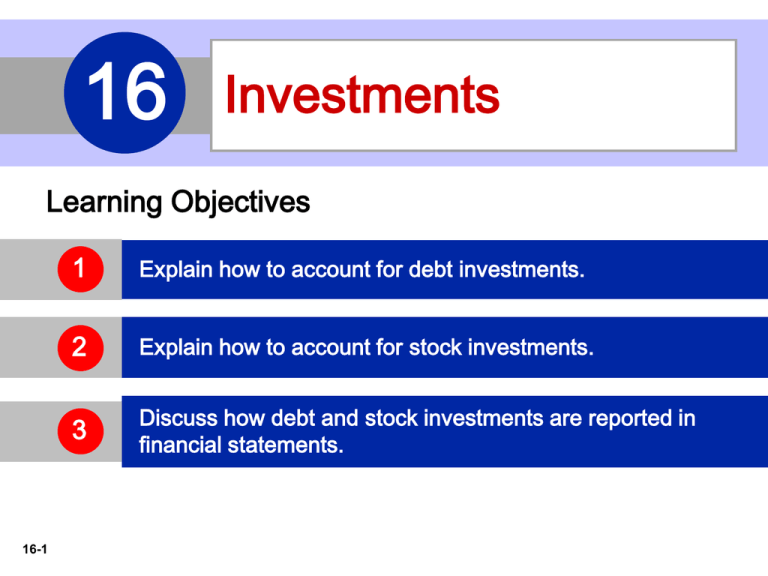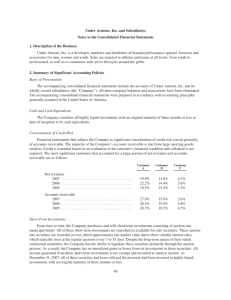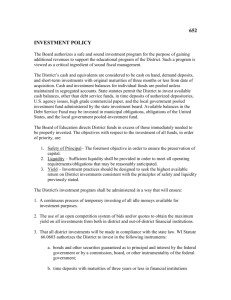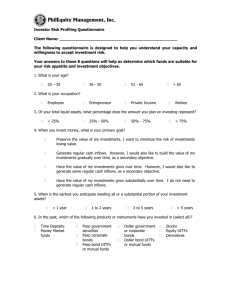
16
Investments
Learning Objectives
16-1
1
Explain how to account for debt investments.
2
Explain how to account for stock investments.
3
Discuss how debt and stock investments are reported in
financial statements.
LEARNING
OBJECTIVE
1
Explain how to account for debt
investments.
Corporations purchase investments in debt or stock
securities generally for one of three reasons.
1. Corporation may have excess cash.
2. Generate earnings from investment income.
3. For strategic reasons.
Illustration 16-1
Temporary investments
and the operating cycle
16-2
LO 1
Why Corporations Invest
Question
Pension funds and banks regularly invest in debt and stock
securities to:
a. house excess cash until needed.
b. generate earnings.
c. meet strategic goals.
d. avoid a takeover by disgruntled investors.
16-3
LO 1
Accounting for Debt Investments
Investments in government and corporation bonds.
Entries are made to record
1. the acquisition,
2. the interest revenue, and
3. the sale.
RECORDING ACQUISITION OF BONDS
Cost includes all expenditures necessary to acquire
these investments, such as the price paid plus brokerage
fees (commissions), if any.
16-4
LO 1
Accounting for Debt Investments
RECORDING BOND INTEREST
Calculate and record interest revenue based upon the
carrying value of the bond
times the interest rate
times the portion of the year the bond is outstanding.
16-5
LO 1
Accounting for Debt Investments
RECORDING SALE OF BONDS
Credit the investment account for the cost of the
bonds.
Record as a gain or loss
► any difference between the net proceeds from the
sale (sales price less brokerage fees) and
► the cost of the bonds.
16-6
LO 1
Accounting for Debt Investments
Illustration: Kuhl Corporation acquires 50 Doan Inc. 8%, 10year, $1,000 bonds on January 1, 2017, for $50,000. The entry
to record the investment is:
Jan. 1
Debt Investments
Cash
16-7
50,000
50,000
LO 1
Accounting for Debt Investments
Kuhl Corporation acquires 50 Doan Inc. 8%, 10-year, $1,000
bonds on January 1, 2017, for $50,000. The bonds pay interest
annually on January 1. If Kuhl Corporation’s fiscal year ends on
December 31, prepare the entry to accrue interest earned by
December 31.
Dec. 31
Interest Receivable
Interest Revenue
4,000 *
4,000
* ($50,000 x 8% = $4,000)
16-8
LO 1
Accounting for Debt Investments
Kuhl reports Interest Receivable as a current asset in the
balance sheet. It reports Interest Revenue under “Other
revenues and gains” in the income statement. Kuhl reports
receipt of the interest on January 1 as follows
Jan. 1
Cash
Interest Receivable
16-9
4,000
4,000
LO 1
Accounting for Debt Investments
Assume that Kuhl corporation receives net proceeds of $54,000
on the sale of the Doan Inc. bonds on January 1, 2016, after
receiving the interest due. Prepare the entry to record the sale
of the bonds.
Jan. 1
Cash
Debt Investments
Gain on Sale of Debt Investments
16-10
54,000
50,000
4,000
LO 1
Accounting for Debt Investments
Question
An event related to an investment in debt securities that
does not require a journal entry is:
a. acquisition of the debt investment.
b. receipt of interest revenue from the debt investment.
c. a change in the name of the firm issuing the debt
securities.
d. sale of the debt investment.
16-11
LO 1
Accounting for Debt Investments
Question
When bonds are sold, the gain or loss on sale is the
difference between the:
a. sales price and the cost of the bonds.
b. net proceeds and the cost of the bonds.
c. sales price and the market value of the bonds.
d. net proceeds and the market value of the bonds.
16-12
LO 1
Investor Insight
Hey, I Thought It Was Safe!
It is often stated that bond investments are safer than stock investments. After all, with an
investment in bonds, you are guaranteed return of principal and interest payments over the
life of the bonds. However, here are some other factors you may want to consider:
• In 2013, the value of bonds fell by 2% due to interest rate risk. That is, when interest rates
rise, it makes the yields paid on existing bonds less attractive. As a result, the price of the
existing bond you are holding falls.
• While interest rates are currently low, it is likely that they will increase in the future. If you
hold bonds, there is a real possibility that the value of your bonds will be reduced.
• Credit risk also must be considered. Credit risk means that a company may not be able to
pay back what it borrowed. Former bondholders in companies like General Motors, United
Air Lines, and Eastman Kodak saw their bond values drop substantially when these
companies declared bankruptcy.
An advantage of a bond investment over stock is that if you hold it to maturity, you will
receive your principal and also interest payments over the life of the bond. But if you have to
sell your bond investment before maturity, you may be facing a roller coaster regarding its
value.
16-13
LO 1
DO IT! 1
Debt Investments
Waldo Corporation had the following transactions pertaining to
debt investments.
Jan. 1, 2017 Purchased 30, $1,000 Hillary Co. 10% bonds for
$30,000. Interest is payable annually on January 1.
Dec. 31, 2017 Accrued interest on Hillary Co. bonds in 2017.
Jan. 1, 2018 Received interest on Hillary Co. bonds.
Jan. 1, 2018 Sold 15 Hillary Co. bonds for $14,600.
Dec. 31, 2018 Accrued interest on Hillary Co. bonds in 2018.
Journalize the transactions.
16-14
LO 1
DO IT! 1
Debt Investments
Waldo Corporation had the following transactions pertaining to
debt investments.
Jan. 1, 2017 Purchased 30, $1,000 Hillary Co. 10% bonds for
$30,000. Interest is payable annually on January 1.
Journalize the transactions.
July 1
(2017)
16-15
Debt Investments
Cash
30,000
30,000
LO 1
DO IT! 1
Debt Investments
Waldo Corporation had the following transactions pertaining to
debt investments.
Dec. 31, 2017 Accrued interest on Hillary Co. bonds in 2017.
Jan. 1, 2018
Received interest on Hillary Co. bonds.
Journalize the transactions.
Dec. 31
(2017)
Jan. 1
(2018)
16-16
Interest Receivable
3,000
Interest Revenue ($30,000 x 10%)
Cash
Interest Receivable
3,000
3,000
3,000
LO 1
DO IT! 1
Debt Investments
Waldo Corporation had the following transactions pertaining to
debt investments.
Jan. 1, 2018
Sold 15 Hillary Co. bonds for $14,600.
Dec. 31, 2018 Accrued interest on Hillary Co. bonds in 2018.
Journalize the transactions.
Jan. 1
(2018)
Cash
Loss on Sale of Debt Investments
14,600
400
Debt Investments ($30,000 x 15/30)
Dec. 31 Interest Receivable
(2018)
16-17
Interest Revenue
15,000
1,500
1,500
LO 1
LEARNING
OBJECTIVE
2
Explain how to account for stock
investments.
Ownership Percentages
0 ------------------20% -------------- 50% -------------------- 100%
No significant
influence
usually exists
Investment
valued using
Cost Method
Significant
influence
usually exists
Investment
valued using
Equity Method
Control usually exists
(50%+ owned)
Investment valued on
parent’s books using Cost
Method or Equity Method
(investment eliminated in
Consolidation)
The accounting depends on the extent of the investor’s influence over
the operating and financial affairs of the issuing corporation (investee).
16-18
LO 2
Accounting for Stock Investments
Holding of Less than 20%
Companies use the cost method.
Investment is recorded at cost and revenue recognized
only when cash dividends are received.
Cost includes all expenditures
necessary to acquire these
investments, such as the price
paid plus any brokerage fees
(commissions), if any.
16-19
Helpful Hint
The entries for investments
in common stock also
apply to investments in
preferred stock.
LO 2
Holding of Less than 20%
RECORDING ACQUISITION OF STOCK
INVESTMENTS
Illustration: On July 1, 2017, Sanchez Corporation acquires 1,000
shares (10% ownership) of Beal Corporation common stock.
Sanchez pays $40 per share. The entry for the purchase is:
July 1
Stock Investments (1,000 x $40)
Cash
16-20
40,000
40,000
LO 2
Holding of Less than 20%
RECORDING DIVIDENDS
Illustration: During the time Sanchez owns the stock it makes
entries for any cash dividends received. If Sanchez receives a $2
per share dividend on December 31, the entry is:
Dec. 31
Cash (1,000 x $2)
Dividend Revenue
16-21
2,000
2,000
LO 2
Holding of Less than 20%
RECORDING SALE OF STOCK
Illustration: Assume that Sanchez Corporation receives net
proceeds of $39,000 on the sale of its Beal stock on February 10,
2018. Because the stock cost $40,000, Sanchez incurred a loss
of $1,000. The entry to record the sale is:
Feb. 10
Cash
Loss on Sale of Stock Investments
Stock Investments
16-22
39,000
1,000
40,000
LO 2
Accounting for Stock Investments
Holding Between 20% and 50%
Equity Method: Investor records the investment at cost
and subsequently adjust the amount each period for the
proportionate share of the earnings (losses) and
dividends received.
If investor’s share of investee’s losses exceeds the carrying amount of the
investment, the investor ordinarily should discontinue applying the equity
method.
16-23
LO 2
Holdings Between 20% and 50%
Illustration: Milar Corporation acquires 30% of the common shares
of Beck Company for $120,000 on January 1, 2017. For 2017,
Beck reports net income of $100,000 and paid dividends of
$40,000. Prepare the entries for these transactions.
Jan. 1
Stock Investments
120,000
Cash
Dec. 31
Stock Investments ($100,000 x 30%)
120,000
30,000
Revenue from Stock Investments
Dec. 31
Cash ($40,000 x 30%)
Stock Investments
16-24
30,000
12,000
12,000
LO 2
Holdings Between 20% and 50%
Illustration: Milar Corporation acquires 30% of the common shares
of Beck Company for $120,000 on January 1, 2017. For 2017,
Beck reports net income of $100,000 and paid dividends of
$40,000. Prepare the entries for these transactions.
After Milar posts the transactions for the year, its investment
and revenue accounts will show the following.
Illustration 16-4
Investment and revenue
accounts after posting
16-25
LO 2
Holdings Between 20% and 50%
Question
Under the equity method, the investor records dividends
received by crediting:
a. Dividend Revenue.
b. Investment Income.
c. Revenue from Investment.
d. Stock Investments.
16-26
LO 2
Accounting for Stock Investments
Holdings of More than 50%
Controlling Interest - When one corporation acquires a voting
interest of more than 50 percent in another corporation
Investor is referred to as the parent.
Investee is referred to as the subsidiary.
Investment in the subsidiary is reported on the parent’s
books as a long-term investment.
Parent generally prepares consolidated financial
statements.
16-27
LO 2
Holdings of More than 50%
Consolidated statements indicate the magnitude and scope
of operations of the companies under common control.
Illustration 16-5
Examples of consolidated companies and their subsidiaries
16-28
LO 2
Accounting Across the Organization
How Procter & Gamble Accounts for Gillette
Several years ago, Procter & Gamble Company acquired Gillette Company for $53.4
billion. The common stockholders of Procter & Gamble elect the board of directors of
the company, who in turn select the officers and managers of the company. Procter &
Gamble’s board of directors controls the property owned by the corporation, which
includes the common stock of Gillette. Thus, they are in a position to elect the board of
directors of Gillette and, in effect, control its operations. These relationships are
graphically illustrated here.
16-29
LO 2
DO IT! 2
Stock Investments
Presented below are two independent situations.
1. Rho Jean Inc. acquired 5% of the 400,000 shares of common
stock of Stillwater Corp. at a total cost of $6 per share on May 18,
2017. On August 30, Stillwater declared and paid a $75,000
dividend. On December 31, Stillwater reported net income of
$244,000 for the year. Prepare all necessary journal entries for
2017.
May 18
Stock Investments (400,000 x 5% x $6)
120,000
Cash
Aug. 30 Cash
Dividend Revenue ($75,000 x 5%)
16-30
120,000
3,750
3,750
LO 2
Presented below are two independent situations.
2. Debbie, Inc. obtained significant influence over North Sails by
buying 40% of North Sails’ 60,000 outstanding shares of common
stock at a cost of $12 per share on January 1, 2017. On April 15,
North Sails declared and paid a cash dividend of $45,000. On
December 31, North Sails reported net income of $120,000 for
the year. Prepare all necessary journal entries for 2017.
Jan. 1
Stock Investments (60,000 x 40% x $12)
288,000
Cash
Apr. 15
Cash
288,000
18,000
Stock Investments ($45,000 x 40%)
Dec. 31 Stock Investments ($120,000 x 40%)
Revenue from Stock Investments
16-31
18,000
48,000
48,000
LO 2
LEARNING
OBJECTIVE
3
Discuss how debt and stock investments are
reported in financial statements.
Categories of Securities
Classifications of debt and stock investments:
Debt Investments
Equity Investments
Trading
Trading
Available-for-sale
Available-for-sale
Held-to-maturity
These guidelines apply to all debt securities and all stock investments in
which the holdings are less than 20%.
16-32
LO 3
Categories of Securities
TRADING SECURITIES
Companies hold with intention of selling in a short
period.
Trading means frequent buying and selling.
Reported at fair value.
Changes from cost are reported in the income
statement as unrealized gains or losses.
16-33
LO 3
Categories of Securities
Question
Marketable securities bought and held primarily for sale
in the near term are classified as:
a. available-for-sale securities.
b. held-to-maturity securities.
c. stock securities.
d. trading securities
16-34
LO 3
TRADING SECURITIES
Illustration: Cost and fair values for investments of
Pace Corporation classified as trading securities on
December 31, 2017.
Illustration 16-7
Valuation of trading
securities
The adjusting entry for Pace Corporation is:
Dec. 31
Fair Value Adjustment—Trading
Unrealized Gain—Income
16-35
7,000
7,000
LO 3
Categories of Securities
AVAILABLE-FOR-SALE SECURITIES
Held with the intent of selling sometime in the future.
Classified as current assets or as long-term assets,
depending on the intent of management.
Reported at fair value.
Changes from cost are reported in stockholders’
equity as unrealized gains or losses.
16-36
LO 3
AVAILABLE-FOR-SALE SECURITIES
Illustration: Assume that Ingrao Corporation has two
securities that it classifies as available-for-sale.
Illustration 16-8
Valuation of availablefor-sale securities
The adjusting entry is:
Dec. 31
Unrealized Gain or Loss—Equity
Fair Value Adjustment—AFS
16-37
9,537
9,537
LO 3
Categories of Securities
Question
An unrealized loss on available-for-sale securities is:
a. reported under Other Expenses and Losses in the
income statement.
b. closed-out at the end of the accounting period.
c. reported as a separate component of stockholders'
equity.
d. deducted from the cost of the investment.
16-38
LO 3
Investor Insight
Can Fair Value Be Unfair?
The FASB is considering proposals for how to account for financial
instruments. The FASB at one time proposed that loans and receivables
be accounted for at their fair value (the amount they could currently be
sold for), as are most investments. The FASB believes that this would
provide a more accurate view of a company’s financial position. It might
be especially useful as an early warning when a bank is in trouble
because of poor-quality loans. But, banks argue that fair values are
difficult to estimate accurately. They are also concerned that volatile fair
values could cause large swings in a bank’s reported net income.
Source: David Reilly, “Bank Face a Mark-to-Market Challenge,” Wall Street
Journal Online (March 15, 2010).
16-39
LO 3
DO IT! 3a
Trading and Available-for-Sale
Securities
Some of Powderhorn Corporation’s investment securities are classified
as trading securities and some are classified as available-for-sale. The
cost and fair value of each category at December 31, 2017, are shown
below.
Unrealized
Cost
Fair Value Gain (Loss)
Trading securities
$93,600
$94,900
$1,300
Available-for-sale securities
$48,800
$51,400
$2,600
At December 31, 2016, the Fair Value Adjustment—Trading account
had a debit balance of $9,200, and the Fair Value Adjustment—
Available-for-Sale account had a credit balance of $5,750. Prepare the
required journal entries for each group of securities for December 31,
2017.
16-40
LO 3
DO IT! 3a
Trading and Available-for-Sale
Securities
Cost
Fair Value
Unrealized
Gain (Loss)
Trading securities
$93,600
$94,900
$1,300
Available-for-sale securities
$48,800
$51,400
$2,600
At December 31, 2016, the Fair Value Adjustment—Trading account
had a debit balance of $9,200, and the Fair Value Adjustment—
Available-for-Sale account had a credit balance of $5,750. Prepare the
required journal entries for each group of securities for December 31,
2017.
Trading securities:
Unrealized Loss—Income ($9,200-$1,300)
Fair Value Adjustment—Trading
16-41
7,900*
7,900
LO 3
DO IT! 3a
Trading and Available-for-Sale
Securities
Cost
Fair Value
Unrealized
Gain (Loss)
Trading securities
$93,600
$94,900
$1,300
Available-for-sale securities
$48,800
$51,400
$2,600
At December 31, 2016, the Fair Value Adjustment—Trading account
had a debit balance of $9,200, and the Fair Value Adjustment—
Available-for-Sale account had a credit balance of $5,750. Prepare the
required journal entries for each group of securities for December 31,
2017.
Available-for-Sale securities:
Fair Value Adjustment—Available-for-Sale
Unrealized Gain or Loss—Equity
16-42
**$5,750 + $2,600
8,350**
8,350
LO 3
Balance Sheet Presentation
SHORT-TERM INVESTMENTS
Also called marketable securities, are securities held by a
company that are
(1) readily marketable and
(2) intended to be converted into cash within the next year or
operating cycle, whichever is longer.
Investments that do not meet both
criteria are classified as long-term
investments.
16-43
Helpful Hint
Trading securities are always
classified as short-term.
Available-for-sale securities
can be either short-term or
long-term.
LO 3
Presentation of Realized and Unrealized
Gain or Loss
Illustration 16-10
Nonoperating items
related to investments
16-44
LO 3
Realized and Unrealized Gain or Loss
Unrealized gains or losses on available-for-sale securities are
reported as a separate component of stockholders’ equity.
Illustration 16-11
Unrealized loss in stockholders’
equity section
16-45
LO 3
Classified Balance Sheet
Illustration 16-12
Classified balance sheet
(Partial Statement)
PACE CORPORATION
Balance Sheet
December 31, 2017
16-46
LO 3
Classified Balance Sheet
Illustration 16-12
Classified balance sheet
(Partial Statement)
PACE CORPORATION
Balance Sheet
December 31, 2017
16-47
LO 3
A Look at IFRS
LEARNING
OBJECTIVE
4
Compare the accounting for investments under
GAAP and IFRS.
Key Points
Similarities
The basic accounting entries to record the acquisition of debt
securities, the receipt of interest, and the sale of debt securities are
the same under IFRS and GAAP.
The basic accounting entries to record the acquisition of stock
investments, the receipt of dividends, and the sale of stock securities
are the same under IFRS and GAAP.
16-48
LO 4
A Look at IFRS
Key Points
Both IFRS and GAAP use the same criteria to determine whether
the equity method of accounting should be used—that is, significant
influence with a general guide of over 20% ownership, IFRS uses
the term associate investment rather than equity investment to
describe its investment under the equity method.
Equity investments are generally recorded and reported at fair value
under IFRS. Equity investments do not have a fixed interest or
principal payment schedule and therefore cannot be accounted for
at amortized cost. In general, equity investments are valued at fair
value, with all gains and losses reported in income, similar to GAAP.
16-49
LO 4
A Look at IFRS
Key Points
Unrealized gains and losses related to available-for-sale securities
are reported in other comprehensive income under GAAP and IFRS.
These gains and losses that accumulate are then reported in the
balance sheet.
Differences
Under IFRS, both the investor and an associate company should
follow the same accounting policies. As a result, in order to prepare
financial information, adjustments are made to the associate’s
policies to conform to the investor’s books. GAAP does not have that
requirement.
16-50
LO 4
A Look at IFRS
Key Points
Differences
In general, IFRS requires that companies determine how to measure
their financial assets based on two criteria:
The company’s business model for managing their financial
assets; and
The contractual cash flow characteristics of the financial asset.
If a company has (1) a business model whose objective is to hold
assets in order to collect contractual cash flows and (2) the
contractual terms of the financial asset gives specified dates to cash
flows that are solely payments of principal and interest on the
principal amount outstanding, then the company should use cost.
16-51
LO 4
A Look at IFRS
Looking to the Future
As indicated earlier, the IASB has issued a new revised IFRS which
deals with the accounting issues related to investment securities. The
FASB is now in the final process of issuing a new standard in this
area. It is likely that some differences will continue to exist between the
IFRS and the FASB regarding investments.
16-52
LO 4
A Look at IFRS
IFRS Self-Test Questions
The following asset is not considered a financial asset
under IFRS:
a) trading securities.
b) held-for-collection securities.
c) equity securities.
d) inventories.
16-53
LO 4
A Look at IFRS
IFRS Self-Test Questions
Under IFRS, the equity method of accounting for long-term
investments in common stock should be used when the
investor has significant influence over an investee and owns:
a) between 20% and 50% of the investee’s common stock.
b) 30% or more of the investee’s common stock.
c) more than 50% of the investee’s common stock.
d) less than 20% of the investee’s common stock.
16-54
LO 4
A Look at IFRS
IFRS Self-Test Questions
Under IFRS, unrealized loss on trading investments should be
reported:
a) as part of other comprehensive loss reducing net income.
b) on the income statement reducing net income.
c) as part of other comprehensive loss not affecting net
income.
d) directly to stockholders’ equity bypassing the income
statement.
16-55
LO 4
Copyright
“Copyright © 2015 John Wiley & Sons, Inc. All rights reserved.
Reproduction or translation of this work beyond that permitted in
Section 117 of the 1976 United States Copyright Act without the
express written permission of the copyright owner is unlawful.
Request for further information should be addressed to the
Permissions Department, John Wiley & Sons, Inc. The purchaser
may make back-up copies for his/her own use only and not for
distribution or resale. The Publisher assumes no responsibility for
errors, omissions, or damages, caused by the use of these programs
or from the use of the information contained herein.”
16-56









